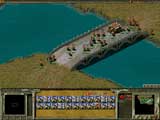 It’s too trendy to point out
how ubiquitous our 21st Century Orientalism has become -- almost as ubiquitous
as the real-time strategy genre. Still, the fact remains that the Far East is a
fascinating place and a staple motif of electronic gaming. Three Kingdoms: Fate of the
Dragon isn’t the first game to utilize the warlord period following the fall of the
Han dynasty as a backdrop for adventure and intrigue. Most notable would be the titles
from Koei, and the most recent of those is Dynasty Warriors for PlayStation 2. Being the
console editor, I feel obligated to note that. However, in Fate of the Dragon, the heroes
and historical figures you encounter become more than just the names of tough guys. Fate
of the Dragon offers some real historical knowledge about a certain time period in China,
and it does it in a package that is mostly enjoyable.
It’s too trendy to point out
how ubiquitous our 21st Century Orientalism has become -- almost as ubiquitous
as the real-time strategy genre. Still, the fact remains that the Far East is a
fascinating place and a staple motif of electronic gaming. Three Kingdoms: Fate of the
Dragon isn’t the first game to utilize the warlord period following the fall of the
Han dynasty as a backdrop for adventure and intrigue. Most notable would be the titles
from Koei, and the most recent of those is Dynasty Warriors for PlayStation 2. Being the
console editor, I feel obligated to note that. However, in Fate of the Dragon, the heroes
and historical figures you encounter become more than just the names of tough guys. Fate
of the Dragon offers some real historical knowledge about a certain time period in China,
and it does it in a package that is mostly enjoyable.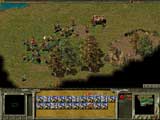 The basic premise of Fate of the
Dragon is this: Playing the head of one of the Three Kingdoms, Cao Cao, Liu Bei, or Sun
Quan, you build your power through the decline of the Han dynasty (circa 220 AD) to the
end of the Three Kingdoms period (around 280 AD). The game is based on the classic novel, Romance
of the Three Kingdoms, usually attributed to Luo Guanzhong. Fans of strategy gaming
might remember Koei’s turn-based series, which shared its name with the novel. The
focus of FOD gives the game a more complete feel, and allows it to be more thorough in
presentation. More than just an Oriental motif is in evidence here – buildings and
characters are very detailed, your workers and soldiers speak Chinese, and the game
manages to create a real visual sense of business among the towns you govern.
The basic premise of Fate of the
Dragon is this: Playing the head of one of the Three Kingdoms, Cao Cao, Liu Bei, or Sun
Quan, you build your power through the decline of the Han dynasty (circa 220 AD) to the
end of the Three Kingdoms period (around 280 AD). The game is based on the classic novel, Romance
of the Three Kingdoms, usually attributed to Luo Guanzhong. Fans of strategy gaming
might remember Koei’s turn-based series, which shared its name with the novel. The
focus of FOD gives the game a more complete feel, and allows it to be more thorough in
presentation. More than just an Oriental motif is in evidence here – buildings and
characters are very detailed, your workers and soldiers speak Chinese, and the game
manages to create a real visual sense of business among the towns you govern.
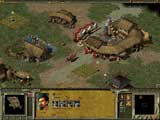 FOD is a
real-time strategy game that relies on standard resource gathering, army building, and
tactical use of force and diplomacy. The first order of business, as usual, is generally
building up your city. For the most part, FOD stays true to the conventions of real-time
strategy: You’ll gather wood and ore, farm corn and pigs, process the raw materials
into food and wine, as well as use combinations of materials to build better structures
and complete research. Some things have been simplified to give the game a focus on
supplying soldiers and managing resources. Research is carried out entirely at the
National Academy, rather than being divided among different buildings. Money is earned
only through taxation, and although it is a crucial ingredient in most production, it is
not the emphasis of the game.
FOD is a
real-time strategy game that relies on standard resource gathering, army building, and
tactical use of force and diplomacy. The first order of business, as usual, is generally
building up your city. For the most part, FOD stays true to the conventions of real-time
strategy: You’ll gather wood and ore, farm corn and pigs, process the raw materials
into food and wine, as well as use combinations of materials to build better structures
and complete research. Some things have been simplified to give the game a focus on
supplying soldiers and managing resources. Research is carried out entirely at the
National Academy, rather than being divided among different buildings. Money is earned
only through taxation, and although it is a crucial ingredient in most production, it is
not the emphasis of the game.
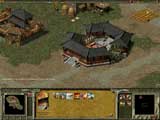 As
you’ll be told time and time again, it is important that your soldiers be
well-supplied to win battles. You’ll need to build supply carts that can become
encampments, and send them to battlesites. Your soldiers become fatigued and hungry
quickly when marching, and they cannot win a battle unless they can refresh themselves.
This creates a tension between continually producing supplies for all of your soldiers,
and keeping the personnel and laborers in your city well-fed.
As
you’ll be told time and time again, it is important that your soldiers be
well-supplied to win battles. You’ll need to build supply carts that can become
encampments, and send them to battlesites. Your soldiers become fatigued and hungry
quickly when marching, and they cannot win a battle unless they can refresh themselves.
This creates a tension between continually producing supplies for all of your soldiers,
and keeping the personnel and laborers in your city well-fed.
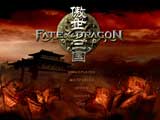 You can
train several different kinds of unit, raise horses for them to ride, and send specialized
artillery and war machines to battle with them. However, during times of peace you can
convert your soldiers back into laborers, and then convert them again into warriors at a
lower cost. You’ll need this labor pool to deal with various natural disasters that
may occur, as well as to rebuild forces for a looming battle.
You can
train several different kinds of unit, raise horses for them to ride, and send specialized
artillery and war machines to battle with them. However, during times of peace you can
convert your soldiers back into laborers, and then convert them again into warriors at a
lower cost. You’ll need this labor pool to deal with various natural disasters that
may occur, as well as to rebuild forces for a looming battle.
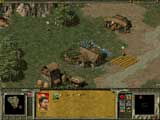 FOD is
very successful at conveying a sense of the passage of time. Things seem to happen fairly
naturally, rather than engaging in disjointed missions. However, the actual mechanics of
the game interfere, and can at times usurp all sense of progress in the game. The game
sports great voice acting, but forces you to read through screen after screen of
background information before each mission. This is the first hint that there is a catch
to an otherwise really enjoyable game. The second becomes noticeable about 20 minutes into
the game, when you try to leave your city.
FOD is
very successful at conveying a sense of the passage of time. Things seem to happen fairly
naturally, rather than engaging in disjointed missions. However, the actual mechanics of
the game interfere, and can at times usurp all sense of progress in the game. The game
sports great voice acting, but forces you to read through screen after screen of
background information before each mission. This is the first hint that there is a catch
to an otherwise really enjoyable game. The second becomes noticeable about 20 minutes into
the game, when you try to leave your city.
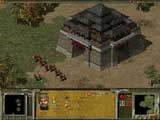 FOD uses
the basic isometric view we’ve gotten used to in real-time strategy titles. In
addition, it provides the stock "corner map" that gives you a bigger, more
iconic view of the area. What is weird in FOD is that there are two maps you must move
between, and they aren’t really dilineated between each other. There is the city map
and the world map. They look identical, and the "corner map" never shows any
difference between them. But when you leave your city area, or when you approach another
city, rather than just walking up to walls, you approach a large, iconic structure, and
you must order your troops to enter. After entering, you find yourself in the countryside
outside the city (which looks a lot like the countryside you just left), and you must now
approach the city walls to begin your battle. This is a real pain at first, becomes easier
to deal with, and rapidly becomes a pain again as you work through more complex missions.
FOD uses
the basic isometric view we’ve gotten used to in real-time strategy titles. In
addition, it provides the stock "corner map" that gives you a bigger, more
iconic view of the area. What is weird in FOD is that there are two maps you must move
between, and they aren’t really dilineated between each other. There is the city map
and the world map. They look identical, and the "corner map" never shows any
difference between them. But when you leave your city area, or when you approach another
city, rather than just walking up to walls, you approach a large, iconic structure, and
you must order your troops to enter. After entering, you find yourself in the countryside
outside the city (which looks a lot like the countryside you just left), and you must now
approach the city walls to begin your battle. This is a real pain at first, becomes easier
to deal with, and rapidly becomes a pain again as you work through more complex missions.
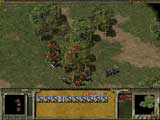 In
addition to the screwy map setup, FOD features the most intrusive fog I’ve ever seen.
This isn’t like your standard "fog of battle" stuff – it’s like
that evil mist Stephen King wrote about that eats whole cities. As you move a laborer or
soldier into the black fog, it disappears, like it should. However, if you move your
troops out of, or through, an area, the fog rapidly closes in until the territory is once
again obscured. It is just silly. Your archers will shoot from your city wall, into the
blackness, but you won’t be able to see the enemy. And if you’re fighting a
battle far away, you can easily lose the entire city you were just attacking. It seems to
me that the warlords of ancient China must have had some idea of where they were going.
Why can’t we?
In
addition to the screwy map setup, FOD features the most intrusive fog I’ve ever seen.
This isn’t like your standard "fog of battle" stuff – it’s like
that evil mist Stephen King wrote about that eats whole cities. As you move a laborer or
soldier into the black fog, it disappears, like it should. However, if you move your
troops out of, or through, an area, the fog rapidly closes in until the territory is once
again obscured. It is just silly. Your archers will shoot from your city wall, into the
blackness, but you won’t be able to see the enemy. And if you’re fighting a
battle far away, you can easily lose the entire city you were just attacking. It seems to
me that the warlords of ancient China must have had some idea of where they were going.
Why can’t we?
Everything becomes even more annoying when you actually conquer another city. Being a
real-time game, you may often be obligated to manage two resource centers, defend them,
and conduct a battle somewhere else, all at the same time. But the map will continue to
hinder you in every way possible, and the fact that it becomes incredibly difficult to
tell cities apart because they look so similar (and you often can’t really see their
location on the map) just compounds the issue. Further, locating your troops on the
battlefield to issue orders is a nightmare. Ultimately, you’ll probably resort to the
pause-order-unpause technique, which is never fun and totally undermines the real-time
aspects of the game.
Overall, Fate of the Dragon isn’t a bad game. It’s a game that could be a lot
better. While it offers a lot in the way of depth, complexity, historical content, and
trendy Asian influences, it falls short in the basic play mechanics. If you’ve got a
good amount of patience, and you love both Chinese history and real-time strategy games,
then you will probably really enjoy this title. However, it’s not going to garner a
lot of newcomers to the genre, and it certainly isn’t for casual strategy fans who
don’t care to spend some time getting the basics down.
